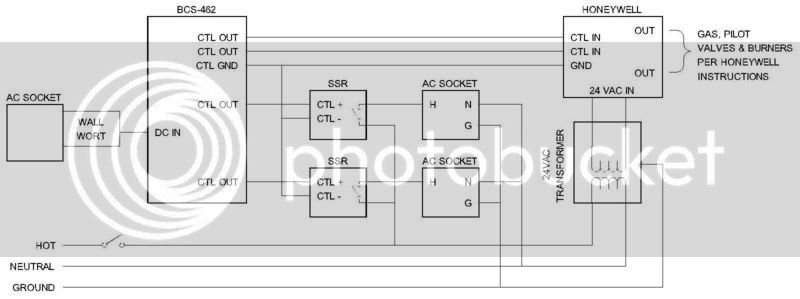The_Gerbil_Brewer
Well-Known Member
I've been searching through a lot of topics on automation and I think the discussions most similar to what I'm looking to do are much more complex than needed. Without any prior experience with electrical work (besides building a stir plate) I'm not able to take what has been explained in those discussions and apply it to my project.
I'm building a single tier, 3 burner HERMS brewstand that will be run on propane. I'll be utilizing the BCS-462, 2 Honeywell Y8610U6006 gas valves with intermittent pilots, and 2 chugger pumps. While I may expand the level of automation in the future, at the moment I'm looking to have the BCS do the following:
- heat strike water and HLT water at the same time
- Maintain HLT water at prescribed temps
- cycle pump on and off to circulate mash liquor through HERMS coil
- record BK temps (plan to manually ignite but would like the BCS to collect data on boil)
I'd like the control panel to have the following characteristics:
- If possible have one plug powering everything (standard GCFI household outlet)
- Not modify pump power cords (i.e. have them plug into outlets controlled by BCS)
- CAT5 outlet on outside of control panel for me to plug my laptop into (which will connect via WiFi)
- Be able to control manually (saw 3 way switches being used in other BCS builds: Off, Manual on, BCS-controlled) in case BCS failed, internet connectivity issues, etc.
- Nice to have, but not necessary: lights indicating when each of the 4 elements is running (2 pumps, 2 gas valves)
I plan to keep the gas valve modules in a separate NEMA enclosure to utilize the wiring harness included with the kits (not very long) and also in hopes of avoiding interference with the BCS. I have a logical thought process but, as stated, have virtually no electrical experience so any and all info/advice is greatly appreciated (e.g what gauge wire, transformer/SSR specs, etc)
I've learned a ton so far through these forums and will make sure to pay any advice given forward. Thanks in advance for any assistance!
I'm building a single tier, 3 burner HERMS brewstand that will be run on propane. I'll be utilizing the BCS-462, 2 Honeywell Y8610U6006 gas valves with intermittent pilots, and 2 chugger pumps. While I may expand the level of automation in the future, at the moment I'm looking to have the BCS do the following:
- heat strike water and HLT water at the same time
- Maintain HLT water at prescribed temps
- cycle pump on and off to circulate mash liquor through HERMS coil
- record BK temps (plan to manually ignite but would like the BCS to collect data on boil)
I'd like the control panel to have the following characteristics:
- If possible have one plug powering everything (standard GCFI household outlet)
- Not modify pump power cords (i.e. have them plug into outlets controlled by BCS)
- CAT5 outlet on outside of control panel for me to plug my laptop into (which will connect via WiFi)
- Be able to control manually (saw 3 way switches being used in other BCS builds: Off, Manual on, BCS-controlled) in case BCS failed, internet connectivity issues, etc.
- Nice to have, but not necessary: lights indicating when each of the 4 elements is running (2 pumps, 2 gas valves)
I plan to keep the gas valve modules in a separate NEMA enclosure to utilize the wiring harness included with the kits (not very long) and also in hopes of avoiding interference with the BCS. I have a logical thought process but, as stated, have virtually no electrical experience so any and all info/advice is greatly appreciated (e.g what gauge wire, transformer/SSR specs, etc)
I've learned a ton so far through these forums and will make sure to pay any advice given forward. Thanks in advance for any assistance!


 ). I'd think it's safe to assume most people on HBT building semi-automated brew stands don't have extensive knowledge in welding, HVAC, and electrical systems and therefore work with this great community to help them sort it out. I have no intention of even beginning this build until I feel confident of all the components and how they need to fit together.
). I'd think it's safe to assume most people on HBT building semi-automated brew stands don't have extensive knowledge in welding, HVAC, and electrical systems and therefore work with this great community to help them sort it out. I have no intention of even beginning this build until I feel confident of all the components and how they need to fit together. 

